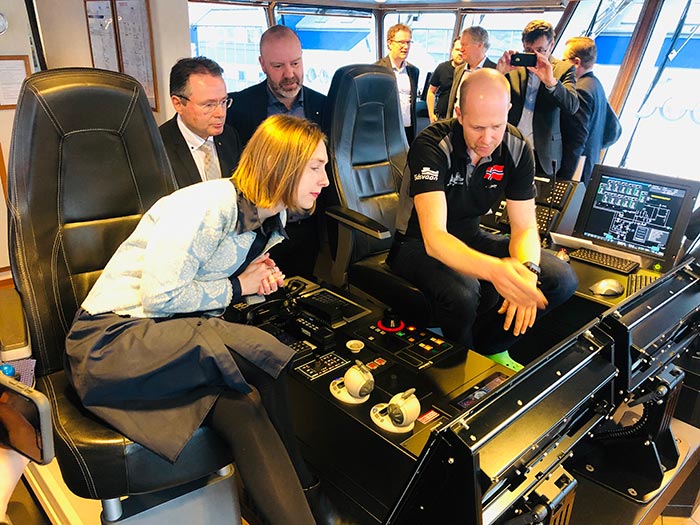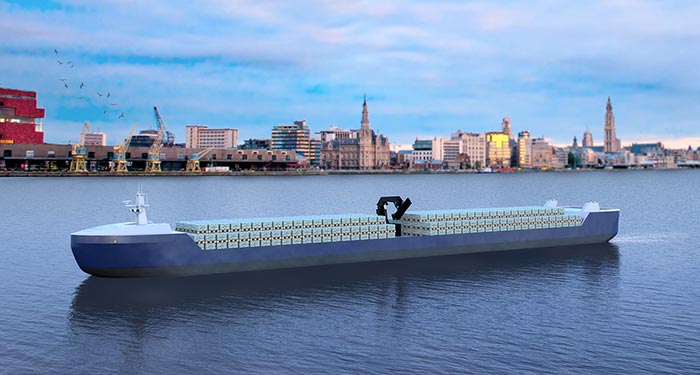
Kongsberg gets EU funding to demo two autonomous vessels
Written by Nick Blenkey
From left: Iselin NybøIselin Nybø, Norway’s Minister of Research and Higher Education, onboard Eidsvaag Pioneer, with Gunnar Pedersen, Vidar Skretting and Johnny Stene
Kongsberg is to install and test autonomous technology on two vessels in different operational environments, with the help of EUR 20.1 million (about $22.3 million) in funding from the EU’s Horizon 2020 research program.
AUTOSHIP, a four-year Horizon 2020 project, is a collaboration between Kongsberg and Norway’s leading research organization, SINTEF, as well as several European partners.
The Research Council of Norway is also providing support.
Two autonomous vessels will be demonstrated for use in short sea coastal shipping and onEurope’s inland waterways.
“The AUTOSHIP project gives Northern Europe with Norway a leading edge in developing the next generation of autonomous vessels. The race is underway internationally,” says Iselin Nybø, Norway’s Minister of Research and Higher Education. “The technology contributes to safer, more efficient and sustainable operations at sea, both in transport and aquaculture. The project now receives one of the largest allocations from the EU’s Horizon 2020 program to a Norwegian player ever. This is a NOK 200 million mark of quality.”
News of the funding was announced at an event in Kristiansund on board the Eidsvaag Pioneer, which is one of the two vessels that will now be equipped for remote-operated and autonomous maritime transport. Owned by the Eidsvaag shipping company it operates along the Norwegian coast and in fjord areas where it carries fish feed to fish-farms.
“The Norwegian maritime cluster, which Kongsberg is part of, is the world leader in autonomous shipping. Now we are further strengthening our position through the AUTOSHIP project which will accelerate the realization of next-generation autonomous ships and create a roadmap for commercializing autonomous shipping in the EU in the next five years,” says Egil Haugsdal, CEO of Kongsberg Maritime.
The markets for both short sea coastal shipping and transport on inland waterways are expected to explode in the next few years, both in Norway, Europe, and worldwide.
“We will demonstrate that it is possible to remotely operate several ships from land and over large geographical areas,” says Haugsdal. “The technology is used in different ways on the vessel to show that the solutions can be applied widely. This is a market with a significant potential.”
The aim of the project is to test and further develop key technology linked to fully autonomous navigation systems, intelligent machinery systems, self-diagnostics, prognostics and operation scheduling, as well as communication technology enabling a prominent level of cyber security and integrating the vessels into upgraded e-infrastructure.
“We will contribute by developing cloud-based communications systems and advanced simulations to test and ensure that the autonomous vessels operate safely and optimally,” says Hege Skryseth, the CEO of Kongsberg Digital.
TAKES 7,500 TRUCKS OFF THE ROADS
The other vessel to be equipped with autonomous technology is a Belgian pallet shuttle barge owned by Blue Line Logistics NV. This operates on canals in Europe, transporting goods to and from large container ports. Europe’s inland waterways can achieve major environmental gains by using new technology. An autonomous barge in operation is expected to take around 7,500 trucks off the roads each year and will result in reductions in both traffic congestion and emissions.
“There is increasing market demand for waterborne transport in the EU. The results of the AUTOSHIP project will lead to safer and greener transport in Europe with one of the major outcomes being a shift of goods transport from roads to waterways,” says Haugsdal.





